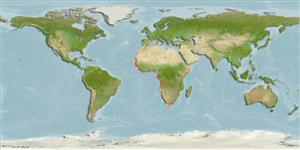Common names from other countries
Environment: milieu / climate zone / depth range / distribution range
Ekologi
; kisaran kedalaman 12 - 400 m (Ref. 435), usually 50 - 150 m (Ref. 435). Tropical
Eastern Atlantic: West Africa from Sahara to Angola.
Length at first maturity / Size / Weight / umur
Maturity: Lm ? range ? - ? cm Max length : 7.6 cm CL jantan/; (Ref. 435)
Maximum carapace width: 9.6 cm. Burrows in mud or sandy mud at depths of 12 to 400m, common at depths of 50 to 150 m (Ref. 435).
Life cycle and mating behavior
Kematangan | Reproduksi, perkembang biakan | Pemijahan | telur-telur | Fecundity | Larva
Members of the order Decapoda are mostly gonochoric. Mating behavior: Precopulatory courtship ritual is common (through olfactory and tactile cues); usually indirect sperm transfer.
rujukan utama
Acuan | Koordinator | mitra
Fischer, W., G. Bianchi and W.B. Scott (eds.). 1981. (Ref. 435)
Status IUCN Red List (Ref. 130435)
status CITES (Ref. 108899)
Not Evaluated
Not Evaluated
ancaman kepada manusia
Harmless
penggunaan manusia
Perikanan: memiliki potensi kepentingan
| FishSource |
Alat, peralatan
informasi lanjut
Umur / SaizPertumbuhanpanjang-beratpanjang-panjangMorfologiLarvaKelimpahan
Sumber internet
Estimates based on models
Preferred temperature
(Ref.
115969): 14.2 - 20.5, mean 16.7 (based on 50 cells).
keancaman
Low vulnerability (10 of 100).
kategori harga
Unknown.
